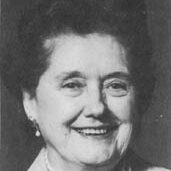Hazel Brannon Smith
- 1983

Fellowship Title:
- A Case Study of an American Community Newspaper Under Pressure
Fellowship Year:
- 1983
Bombed, Burned, and Boycotted
(Editor’s note: Hazel Brannon Smith won the 1964 Pulitzer Prize for her editorials). LEXINGTON, Miss.–The years of trouble began in 1954. A prominent local man walked into my newspaper office one hot day in July and asked to talk to me privately. I owned and edited The Lexington Advertiser, the only newspaper in Lexington, a town of 2,500 that was 55 miles north of Jackson. He told me that a meeting was going to be held that night at the Lexington Elementary School. I naturally assumed that he wanted publicity for the meeting, but he said only men would be allowed to attend. He said he wanted my “cooperation” with something called a “Citizens’ Council,” to be organized that night. The U.S. Supreme Court had just weeks before handed down its landmark decision against school segregation. The Citizens’ Council, he said, would work to maintain segregation in the public schools using legal, nonviolent tactics. “If a Nigra won’t go along with our thinking on what’s best for the community as a whole,” the man told
Separate But Unequal
There is never a good time for a gun battle to take place in a rural community between officers of the law and an armed man. But in an incident where all law enforcement officers are white–and the 28year-old gunman black–and a posse of over 100 white men is called to apprehend the gunman, a disaster was inevitable. It happened in Holmes County, Mississippi in January, 1954. The argument began in a country store in an isolated area not too far from Lexington, seat of Holmes County, where I owned and edited the Lexington Advertiser & Durant News. That area had long been regarded as a place where the “best moonshine in the world” was made. It was illegal, of course, but that did not stop many whites or blacks who “made their own and sold” the remainder to a thirsty public. The initial argument was reported to be between a white country store owner and his son, and a black man who came into the store with bottles of whiskey sticking out of his

Looking at the Old South Through Hazel Eyes
There were about 125 students in the Gadsden, Alabama High School senior class of 1930. The editor of the yearbook had the bright idea of using three adjectives to describe each member of the class. Under the name of Hazel Brannon, it read: “Industrious, Independent, Indomitable.” I’ve learned since that those three qualities are not only valuable for a newspaper editor and publisher, but absolutely necessary if one is to survive and succeed. It’s too bad the members of the White Citizens’ Councils who wanted me dead, or at least out of Mississippi, many years later did not know about those three “I” descriptions of me as a high school senior. It would have saved all of us a lot of trouble and heartbreak. At the age of 18–after having worked for a weekly newspaper for nearly two years–I made up my mind what I wanted to do in life: edit and publish a weekly newspaper of my own. But I had to get my college degree from the University of Alabama first. Then I
